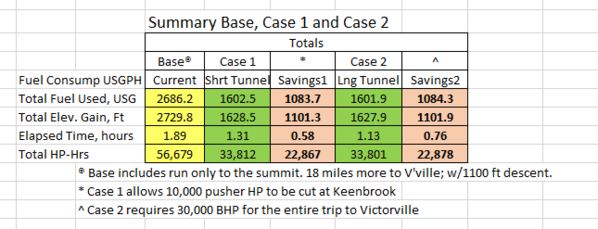So I have been playing with this a bit more. Looking at the Cajon Pass elevation profile it occurred to me that BNSF could make the 2700 ft climb a bunch easier by tunneling under the summit. I looked at two cases.
Case 1 involves the current trackage up to Keenbrook, then a new 19 mile bored inclined tunnel under the mountain, emerging in the area of Frost/Victorville. The tunnel would climb at a leisurely 0.518% grade and eliminate about 1100 ft of ascent and descent up to the summit at 3800 ft ASL.
Case 2 would be a longer 23.5 mile inclined tunnel right from BaseLine to Frost/Victorville. This would climb at a grade of 1.312% and again completely eliminate the summit. Attached is a clip summarizing the current summit climb, along with Case 1 and 2 highlights.
You can see that Case 1 saves almost 1100 gallons of fuel for the example 18,500 ton train, plus 0.58 hours travel time, and almost 23,000 HP-hours of engine usage. It also allows dropping 10,000 hp of pushers at Keenbrook because the rest of the trip can be made with only 20,000 hp. The cutoff pushers can then quickly head back down to SB for use with the next train.
Case 2 has about the same fuel and engine use savings; the only significant difference is it saves 0.76 hours travel time compared to the base case. Also in this case you still need the full 30,000 hp worth of power, so your pushers are going to wind up in Frost/Victorville, which is a much longer return trip to SB. Providing the tunnel is two track, there would be no need for westbound traffic to go over the summit anymore, and therefore no need for westbound pushers.
Note that the time savings for both tunnel cases is actually a little better than 0.58 & 0.76 hours, because you have to add the travel time from the summit down to frost/Victorville to the base case. This is about 18-19 miles long and depending on speed restrictions would take perhaps 30 minutes give or take. So the actual time savings to Frost/Victorville would be more like 1.08 & 1.26 hours. In my mind Case 1 option looks best. The tunnel is shorter, fuel burn is the same, and it saves almost the same amount of time, and 10,000 hp of pushers cuts off at Keenbrook. Both options also off much simpler track alignment, much reduced flange wear and tear due to much reduced curves, and no snow removal through the pass in winter (though I have no idea if this pass gets snow or not).
Is such a scheme even feasible? No doubt BNSF have looked at a few ideas and tunnelling may be too expensive. It's not impossible because CP did a 9 mile long bored tunnel through the solid granite of Mount MacDonald in Rogers pass in the late 1980's, mind you it was single track; not double. A Cajon tunnel would be twice as long and need a sophisticated ventilation system. But I have no doubt BNSF have the engineering expertise to make it happen. To do a project like this in Canada these days would likely not be economically feasible what with tree-huggers, lobbyist groups, save the planet types, First-Nations legal hassles, environmental studies up the wazoo, etc, etc, etc. 
What do you folks think?
Rod




